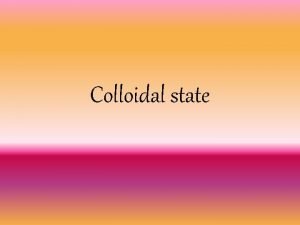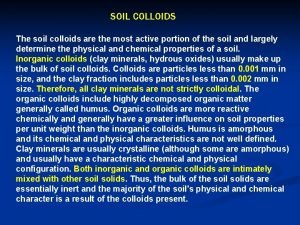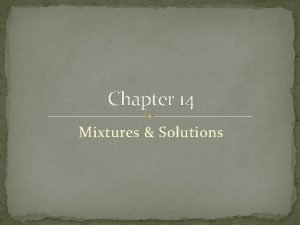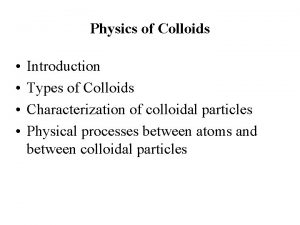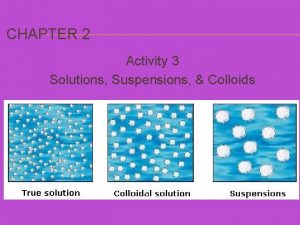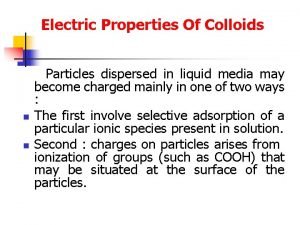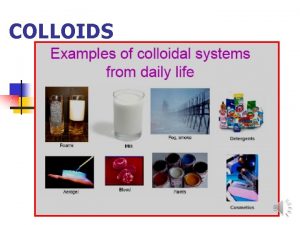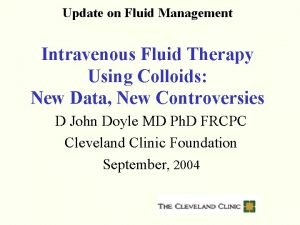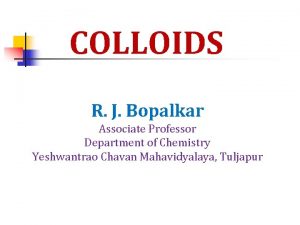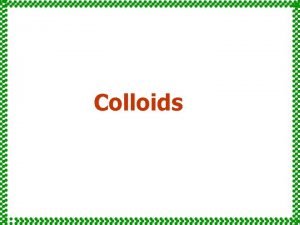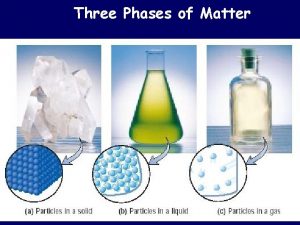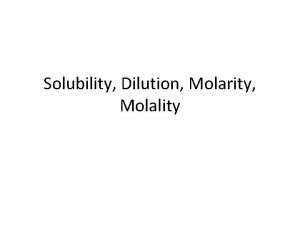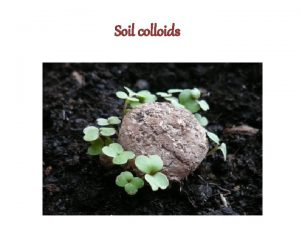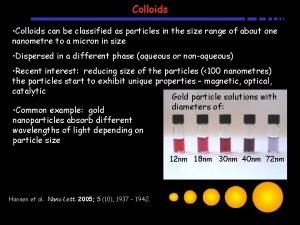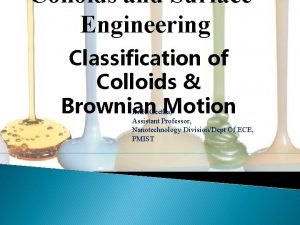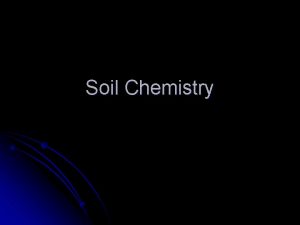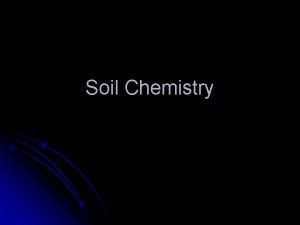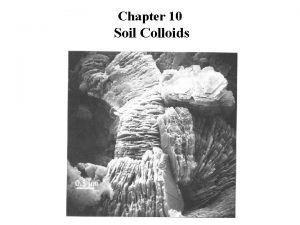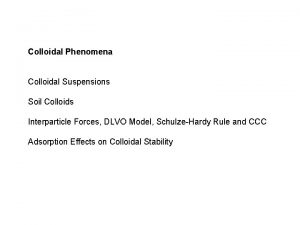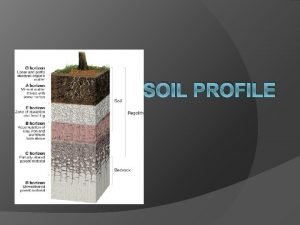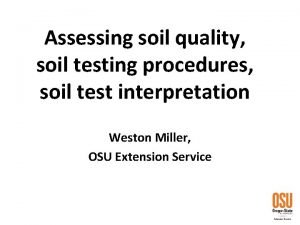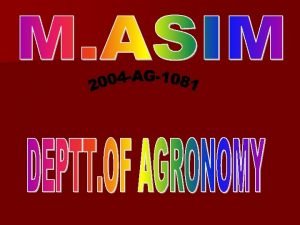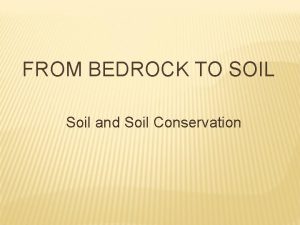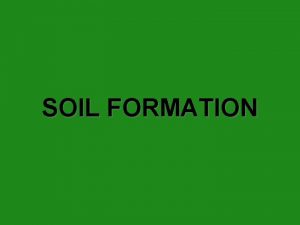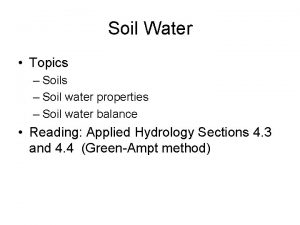SOIL COLLOIDS The soil colloids are the most





























- Slides: 29

SOIL COLLOIDS The soil colloids are the most active portion of the soil and largely determine the physical and chemical properties of a soil. Inorganic colloids (clay minerals, hydrous oxides) usually make up the bulk of soil colloids. Colloids are particles less than 0. 001 mm in size, and the clay fraction includes particles less than 0. 002 mm in size. Therefore, all clay minerals are not strictly colloidal. The organic colloids include highly decomposed organic matter generally called humus. Organic colloids are more reactive chemically and generally have a greater influence on soil properties per unit weight than the inorganic colloids. Humus is amorphous and its chemical and physical characteristics are not well defined. Clay minerals are usually crystalline (although some are amorphous) and usually have a characteristic chemical and physical configuration. Both inorganic and organic colloids are intimately mixed with other soil solids. Thus, the bulk of the soil solids are essentially inert and the majority of the soil's physical and chemical character is a result of the colloids present.

Cation exchange One of the most important properties of colloids is their ability to adsorb, hold, and release ions. Colloids generally have a net negative charge as a result of their physical and chemical composition. This negative charge is balanced by thousands of cations. Thus, colloids can be viewed as huge anions surrounded by a swarm of rather loosely held cations. Water molecules are also adsorbed to colloid surfaces; they are present as part of the hydrated structure of the cations. The amount of water associated with a particular cation is important, because the effective radius of the cation changes with the amount of hydration, or associated water

In humid regions, the cations associated with the colloids are dominated by Ca+2, H+, and often A 1+3, resulting in acidic soils. As the soil becomes more acid, H+ and Al+3 become more predominant. The cations Mg+2, K+, and Na+ are usually found in lesser amounts, while NH 4+ may be present in considerable quantities if the soil has been recently fertilized with ammonium fertilizers. In semiarid and arid regions, Ca 2+ usually dominated the cations, but Mg 2+ and Na+ are often found in large quantities. H+ and A 13+ are usually present only in small concentrations. Many of the other plant nutrient cations are found only in very small amounts as cations on colloidal surfaces. More often, they are found as chelates or in chemical combination. Such cations include Mn+2, Zn+2, Cu+2, Fe+2, and Fe+3 and generally make up only a small percent of the exchangeable cations. Anionic nutrients, such as NO 3 -, C 1 -, SO 4 -2, and PO 4 -3 are not held on the surfaces of colloids to any great extent. Instead, they exist as free anions in the soil solution or fixed within chemical compounds.

Cation exchange is the exchange of a cation in the soil solution for another on the surface of a colloid. Cation exchange is a phenomena which is constantly going in soils and is of great importance. Without some mechanism to temporarily hold cations in the soil, plants would be unable to obtain sufficient quantities of the essential nutrients to grow. Without cation exchange, the nutrients would simply be leached downward in the soil and lost. Cation exchange plays a role in other soil processes as well. Acidification is the process of exchanging basic cations, such as Ca+2, Mg+2, K+, and Na+, for acidic cations, such as H+ and A 1+3. Liming acid soils results in a reversal of this process, H+ ions are exchanged for Ca+2 ions. If cationic fertilizer nutrients are not held by the soil colloids, the nutrients would be lost to percolation water

Flocculation and Dispersion Soils are generally in an aggregated state. Aggregation, however, is dependent on the soil colloids and the cations associated with them. Soil colloids can be in either a flocculated or dispersed state. The normal situation is for colloids to be in a flocculated state. Individual particles stick together to form aggregates of particles or floccules. Such aggregates do not move in the soil solution and form the basis for soil structure. When soil particles are dispersed, aggregates do not form, and each particle behaves as an individual. Without aggregation, water, air, and root movement in the soil is inhibited. Thus, dispersion is not a desirable characteristic of productive soils.

The type of cations present in the soil solution determines whether a soil is dispersed or flocculated. Sodium cations cause dispersion while calcium, magnesium, aluminum, and hydrogen ions promote flocculation. Because colloids are simply large anions, they attract cations in order to neutralize their negative charge. Flocculating cations sufficiently neutralize the negative charge, allowing colloids to adhere and flocculate. The attraction of particular cations to the negatively charged colloids is a function of two things, the hydrated size of the cation and the charge of the cation. These two factors combine to determine the charge density on the cation, in other words, the distribution of charge over the surface of the cation. For example, with the highly hydrated Na+ cation, the hydrated size of the cation is relatively large, while its charge is only +1. So, that +1 charge has to be distributed over a relatively large area. With such a large cation having such a low charge, the negative charge on the colloids is not sufficiently satisfied and the colloids actually repel one another, resulting in dispersion.

Shrinking and Swelling Soils shrink and swell as they dry and rewet. Shrinking and swelling is an important factor in the construction of bridges, roads, and buildings, because of the pressures exerted by swelling or expanding soils on the foundations of such structures. Shrinking and swelling is largely a function of the type of colloid present, particularly clay colloids. As water moves in and out of clay crystal lattices, they respond by expanding or contracting. Extreme expansion and contraction is exhibited by clays such as montmorillonite, which have expanding lattices. Clays with nonexpanding lattices, such as kaolinite and chlorite, have very little capacity to shrink and swell.

Colloidal Properties 1. Size - extremely small 2. Surface area - very large 3. Surface charge )a) most soils = electronegative charge dominates )b) results in ion (cation) adsorption

Types of Colloids 1. Layer silicate clays

2 - Hydrous oxides of Fe and Al )a) highly weathered soils & coatings (b) some have structure, others poorly structured (c) examples: gibbsite, Al(OH)3; goethite, Fe. OOH 3 -Allophane and other amorphous minerals

4. Organic colloids )a) highly charged (p. H dependant( )b) phenolic and carboxyl OH groups

Adsorbed cations )a) arid region soils = "basic" cations Ca+2, Mg+2, K+, Na+ )b) humid region soils = "acidic" cations as well Ca+2, Mg+2, H+ and Al+3 )c) strength of adsorption Al+3> Ca+2 = Mg+2 > K+ = NH 4+ > Na+


O Si Si. O 4 -

O/Si= 4/1 O/Si= 2/1


C. Layer Silicate Clay Structure- basic building blocks 1. Tetrahedron - Si. O 4 Sharing of O or OH groups = sheets and unit layers (a) tetrahedral sheet

2. Octahedron - Al(OH)6 octahedral sheet

Tetrahedral and octahedral sheets are often drawn as shown below

1: 1 Type Minerals 1. Mostly, kaolinite

Unit layers H-bonded together è "fixed lattice type" no interlayer activity no shrink-swell only external surface 3. Well crystallized (a) little isomorphous substitution low cation adsorption (b) larger particle size (0. 1 - 5 m m) - hexagonal shaped

Type Minerals . 1 Expanding lattice )a) Smectite group (mostly, montmorillonite (

(b) Freely expanding water in interlayer = large shrink-swell adsorbed cations in interlayer - offset the isomorphous substitution large internal surface (c) Poorly crystallized small size isomorphous substitution = large cation adsorption

Vermiculite similar to smectites except Al+3 for Si+4 in tetrahedral layer interlayer ions are more structured )Mg+2 + H 2 O) limited expansion large cation adsorption

Non-expanding lattice (a) Fine-grained micas or illite Al+3 and K+ substitute for Si+4 (tetrahedral sheet) u weathering at edges = release of K+ very limited expansion medium cation adsorption limited internal surface properties between kaolinite and vermiculite

Chlorites u Mg-octahedral sheet replace K+ of illite u properties similar to illite

Summary of Properties Surface Area (m 2/g) Interlayer Cation Size (mm) External Internal Kaolinite 0. 1 -5. 0 10 -50 - 0. 7 5 -15 Smectite <1. 0 70 -150 500 -700 1. 0 -2. 0 85 -110 Vermiculite 0. 1 - 5. 0 50 -100 450 -600 1. 0 -1. 4 100 -120 Illite 0. 1 -2. 0 50 -100 5 -100 1. 0 15 -40 coatings - - - 100 -300 Humus Spacing (nm) Sorption

Clay Genesis and Distribution . 1 Stages of weathering )a) alkali metals and alkaline earths dissolve )Na+, K+, Ca+2, Mg+2( )b) Si dissolves and leaches )c) continual reforming of new clay minerals Clays reflect weathering processes Young, weakly weathered soils = fine-grained mica, chlorite, vermiculite Intermediate weathering = vermiculite, smectite, kaolinite Strong weathering = kaolinite, hydrous oxides

 Mikael ferm
Mikael ferm Colloids definition
Colloids definition Tyndall effect
Tyndall effect Types of soil colloids
Types of soil colloids Soil horizon ppt
Soil horizon ppt Four major spheres of the earth
Four major spheres of the earth Living soil vs dead soil
Living soil vs dead soil Chapter 14 mixtures and solutions
Chapter 14 mixtures and solutions Colloidal solution example
Colloidal solution example Solutions, suspensions and colloids activity
Solutions, suspensions and colloids activity Examples of colloids food
Examples of colloids food Protective colloids
Protective colloids Kinetic properties of colloids
Kinetic properties of colloids Colloids fluids examples
Colloids fluids examples Colloids examples nursing
Colloids examples nursing Crystalloid solution example
Crystalloid solution example Difference between crystalloids and colloids
Difference between crystalloids and colloids 4-2-1 rule
4-2-1 rule Pharmaceutical colloids
Pharmaceutical colloids Colloids and interfaces
Colloids and interfaces Examples of colloids in chemistry
Examples of colloids in chemistry Not transparent solution suspension colloid
Not transparent solution suspension colloid Colloid examples
Colloid examples Shampoo colloid uses
Shampoo colloid uses Difference between colloids and crystalloids
Difference between colloids and crystalloids Suspension and colloids
Suspension and colloids Aqeedah in islam
Aqeedah in islam Guddi baji
Guddi baji In the name of allah the most beneficent the most merciful
In the name of allah the most beneficent the most merciful In the name of allah the most gracious
In the name of allah the most gracious

